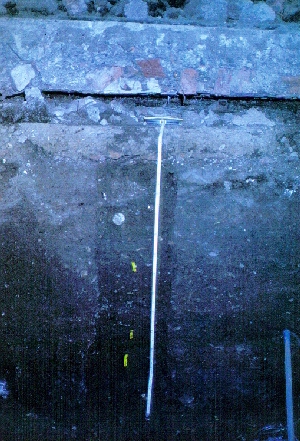
Thirteen moisture cells were inserted into the four exposed profiles of the inspection chamber on 19 June 1995 (see figure 6). The varied nature of the deposits necessitated supervision by the EAU to ensure that the cells were inserted into material of archaeological interest. The deposits identified and into which cells were inserted included organic-rich material (possibly cess), silty clay material (pit fills) and ashy layers. At each point a slit was made and the cell pushed to a depth of approximately 100mm into the deposit. Care was taken to ensure that intimate contact between the cells and deposit was achieved at all times.
Yellow tags marking the position of cell insertion within the south-facing profile of the inspection chamber are shown in Figure 9. The figure also shows a redundant concrete floor directly above the deposit and, above that, a more modern concrete slab of the former shop floor.
At the points of insertion, two samples were taken for laboratory analysis. A disturbed sample was taken to provide sufficient material for laboratory determination of pH, electrical conductivity, and percentage organic matter. Then a density ring was used to obtain an undisturbed core sample from which values for field moisture content (gravimetric and volumetric) and dry bulk density could be calculated. A gravimetric moisture content is determined when a known weight of a sample is dried in an oven at a temperature of 100-110°C, then weighed again and the moisture loss by heating calculated. A moisture content expressed as a volume percentage is the volume of soil water as a percentage of the volume of the soil sample.
Figure 9: Archaeological deposit within inspection chamber

The positioning of the cells and the results of the laboratory analysis are provided.
Once inserted the cells were connected to one of three dataloggers which had been configured to log the resistance of all thirteen cells, and temperature from eight of the cells. The temperature of each cell, logged as a value in degrees centigrade, reflects the temperature of the surrounding deposit. Logged as a value in ohms, the varying resistance of each cell is used as an indicator of moisture change. Resistance values of each cell were recorded before and after installation. No cell temperature data have as yet been collected.
The datalogger to which the cells are attached and the lap-top used to download the monitoring data are shown in Figure 10.
Figure 10: Downloading the monitoring data

The conversion of a cell's resistance into a field moisture content, requires reference to a calibration curve. The varied nature of the deposits, however, prevented a reliable calibration being performed and so moisture change over time and spatially down the profile is reported, rather than absolute values. This is discussed further in the section on Design and installation of the monitoring devices.
© Author(s). Content published prior to 2013 is not covered by CC-BY licence and requests for reproduction should usually go to the copyright holder (in most cases, the author(s)). For citation / fair-dealing purposes, please attribute the author(s), the title of the work, the Internet Archaeology journal and the relevant URL/DOI.
Last updated: Thur Feb 28 2002